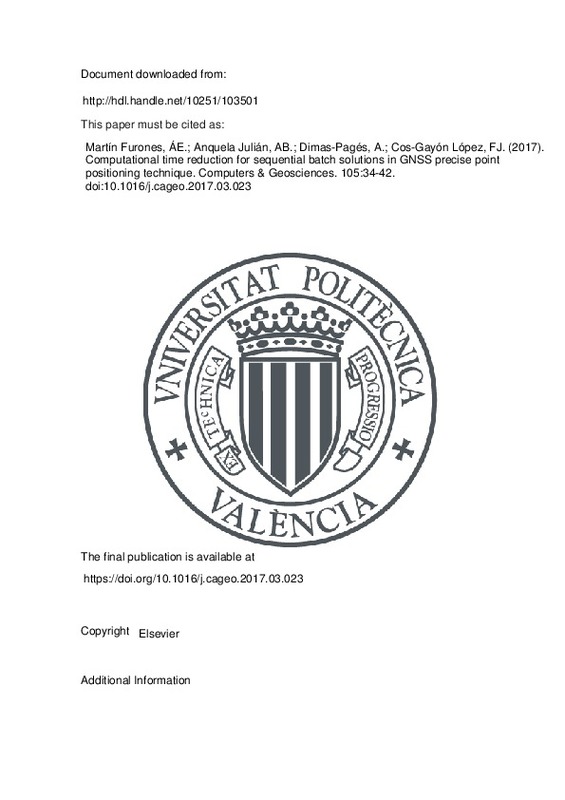JavaScript is disabled for your browser. Some features of this site may not work without it.
Buscar en RiuNet
Listar
Mi cuenta
Estadísticas
Ayuda RiuNet
Admin. UPV
Computational time reduction for sequential batch solutions in GNSS precise point positioning technique
Mostrar el registro sencillo del ítem
Ficheros en el ítem
| dc.contributor.author | Martín Furones, Ángel Esteban
|
es_ES |
| dc.contributor.author | Anquela Julián, Ana Belén
|
es_ES |
| dc.contributor.author | Dimas-Pagés, Alejandro
|
es_ES |
| dc.contributor.author | Cos-Gayón López, Fernando José
|
es_ES |
| dc.date.accessioned | 2018-06-07T04:27:54Z | |
| dc.date.available | 2018-06-07T04:27:54Z | |
| dc.date.issued | 2017 | es_ES |
| dc.identifier.issn | 0098-3004 | es_ES |
| dc.identifier.uri | http://hdl.handle.net/10251/103501 | |
| dc.description.abstract | [EN] Precise point positioning (PPP) is a well established Global Navigation Satellite System (GNSS) technique that only requires information from the receiver (or rover) to obtain high-precision position coordinates. This is a very interesting and promising technique because eliminates the need for a reference station near the rover receiver or a network of reference stations, thus reducing the cost of a GNSS survey. From a computational perspective, there are two ways to solve the system of observation equations produced by static PPP either in a single step (so-called batch adjustment) or with a sequential adjustment/filter. The results of each should be the same if they are both well implemented. However, if a sequential solution (that is, not only the final coordinates, but also those observed in previous GNSS epochs), is needed, as for convergence studies, finding a batch solution becomes a very time consuming task owing to the need for matrix inversion that accumulates with each consecutive epoch. This is not a problem for the filter solution, which uses information computed in the previous epoch for the solution of the current epoch. Thus filter implementations need extra considerations of user dynamics and parameter state variations between observation epochs with appropriate stochastic update parameter variances from epoch to epoch. These filtering considerations are not needed in batch adjustment, which makes it attractive. The main objective of this research is to significantly reduce the computation time required to obtain sequential results using batch adjustment. The new method we implemented in the adjustment process led to a mean reduction in computational time by 45%. | es_ES |
| dc.description.sponsorship | This research was supported by the Spanish Science and Innovation Directorate project number AYA2010-18706 and the Generalitat Valenciana Geronimo Forteza research program with project number FPA/2014/056. | en_EN |
| dc.language | Inglés | es_ES |
| dc.publisher | Elsevier | es_ES |
| dc.relation.ispartof | Computers & Geosciences | es_ES |
| dc.rights | Reserva de todos los derechos | es_ES |
| dc.subject | Precise point positioning | es_ES |
| dc.subject | Batch processing | es_ES |
| dc.subject | Computational time reduction | es_ES |
| dc.subject.classification | CONSTRUCCIONES ARQUITECTONICAS | es_ES |
| dc.subject.classification | INGENIERIA CARTOGRAFICA, GEODESIA Y FOTOGRAMETRIA | es_ES |
| dc.title | Computational time reduction for sequential batch solutions in GNSS precise point positioning technique | es_ES |
| dc.type | Artículo | es_ES |
| dc.identifier.doi | 10.1016/j.cageo.2017.03.023 | es_ES |
| dc.relation.projectID | info:eu-repo/grantAgreement/MICINN//AYA2010-18706/ES/HACIA UNA NUEVA GENERACION EN POSICIONAMIENTO Y NAVEGACION. EVALUACION Y OPTIMIZACION DE LA TECNICA DE POSICIONAMIENTO PUNTUAL PRECISO (PPP)/ | es_ES |
| dc.relation.projectID | info:eu-repo/grantAgreement/GVA//FPA%2F2014%2F056/ | es_ES |
| dc.relation.projectID | info:eu-repo/grantAgreement/Generalitat Valenciana/Programa Gerónimo Forteza/FPA%2F2014%2F056/ES/FPA%2F2014%2F056/ | es_ES |
| dc.rights.accessRights | Abierto | es_ES |
| dc.date.embargoEndDate | 2019-08-01 | es_ES |
| dc.contributor.affiliation | Universitat Politècnica de València. Departamento de Construcciones Arquitectónicas - Departament de Construccions Arquitectòniques | es_ES |
| dc.contributor.affiliation | Universitat Politècnica de València. Departamento de Ingeniería Cartográfica Geodesia y Fotogrametría - Departament d'Enginyeria Cartogràfica, Geodèsia i Fotogrametria | es_ES |
| dc.description.bibliographicCitation | Martín Furones, ÁE.; Anquela Julián, AB.; Dimas-Pagés, A.; Cos-Gayón López, FJ. (2017). Computational time reduction for sequential batch solutions in GNSS precise point positioning technique. Computers & Geosciences. 105:34-42. https://doi.org/10.1016/j.cageo.2017.03.023 | es_ES |
| dc.description.accrualMethod | S | es_ES |
| dc.relation.publisherversion | https://doi.org/10.1016/j.cageo.2017.03.023 | es_ES |
| dc.description.upvformatpinicio | 34 | es_ES |
| dc.description.upvformatpfin | 42 | es_ES |
| dc.type.version | info:eu-repo/semantics/publishedVersion | es_ES |
| dc.description.volume | 105 | es_ES |
| dc.relation.pasarela | S\338387 | es_ES |
| dc.contributor.funder | Generalitat Valenciana | es_ES |
| dc.contributor.funder | Ministerio de Economía y Competitividad | es_ES |







![[Cerrado]](/themes/UPV/images/candado.png)

